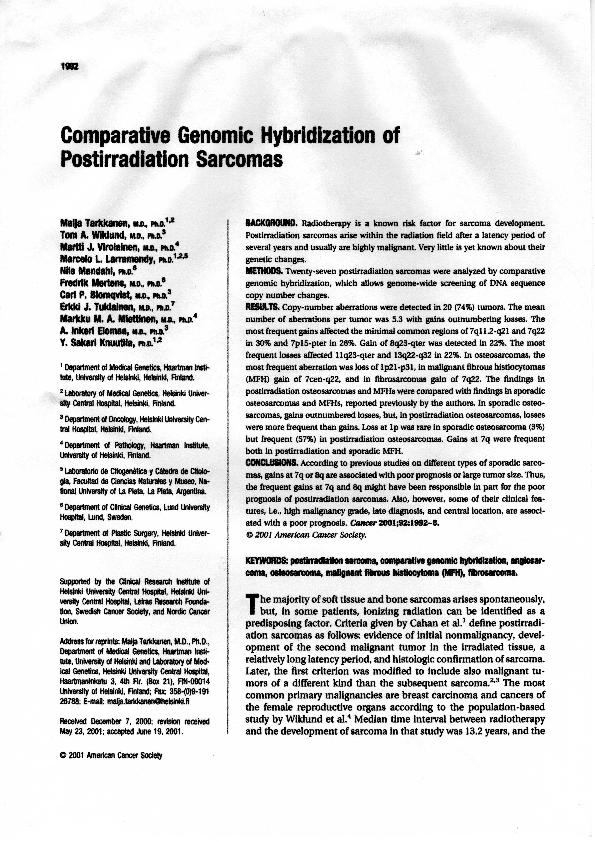Mostrar el registro sencillo del ítem
dc.contributor.author
Tarkkanen, Maija
dc.contributor.author
Wiklund, Tom A.
dc.contributor.author
Virolainen, Martti J.
dc.contributor.author
Larramendy, Marcelo Luis

dc.contributor.author
Mandahl, Nils
dc.contributor.author
Mertens, Fredrik
dc.contributor.author
Blomqvist, Carl P.
dc.contributor.author
Tukiainen, Erkki J.
dc.contributor.author
Miettinen, Markku M. A.
dc.contributor.author
Elomaa, A. Inkeri
dc.contributor.author
Knuutila, Y. Sakari
dc.date.available
2021-12-17T13:49:11Z
dc.date.issued
2001-10-08
dc.identifier.citation
Tarkkanen, Maija; Wiklund, Tom A.; Virolainen, Martti J.; Larramendy, Marcelo Luis; Mandahl, Nils; et al.; A comparative genomic hybridization study on postirradiation sarcomas; John Wiley & Sons Inc; Cancer; 92; 7; 8-10-2001; 1992-1998
dc.identifier.issn
0008-543X
dc.identifier.uri
http://hdl.handle.net/11336/148939
dc.description.abstract
Background: Radiotherapy is a known risk factor for sarcoma development. Postirradiation sarcomas arise within the radiation field after a latency period of several years and usually are highly malignant. Very little is yet known about their genetic changes. Methods: Twenty-seven postirradiation sarcomas were analyzed by comparative genomic hybridization, which allows genome-wide screening of DNA sequence copy number changes. Results: Copy-number aberrations were detected in 20 (74%) tumors. The mean number of aberrations per tumor was 5.3 with gains outnumbering losses. The most frequent gains affected the minimal common regions of 7q11.2-q21 and 7q22 in 30% and 7p15-pter in 26%. Gain of 8q23-qter was detected in 22%. The most frequent losses affected 11q23-qter and 13q22-q32 in 22%. In osteosarcomas, the most frequent aberration was loss of 1p21-p31, in malignant fibrous histiocytomas (MFH) gain of 7cen-q22, and in fibrosarcomas gain of 7q22. The findings in postirradiation osteosarcomas and MFHs were compared with findings in sporadic osteosarcomas and MFHs, reported previously by the authors. In sporadic osteosarcomas, gains outnumbered losses, but, in postirradiation osteosarcomas, losses were more frequent than gains. Loss at 1p was rare in sporadic osteosarcoma (3%) but frequent (57%) in postirradiation osteosarcomas. Gains at 7q were frequent both in postirradiation and sporadic MFH. Conclusions: According to previous studies on different types of sporadic sarcomas, gains at 7q or 8q are associated with poor prognosis or large tumor size. Thus, the frequent gains at 7q and 8q might have been responsible in part for the poor prognosis of postirradiation sarcomas. Also, however, some of their clinical features, i.e., high malignancy grade, late diagnosis, and central location, are associated with a poor prognosis.
dc.format
application/pdf
dc.language.iso
eng
dc.publisher
John Wiley & Sons Inc

dc.rights
info:eu-repo/semantics/openAccess
dc.rights.uri
https://creativecommons.org/licenses/by-nc-sa/2.5/ar/
dc.subject
Postirradiation sarcomas
dc.subject
Comparative genomic hybridization
dc.subject
Angiosarcoma
dc.subject
Osteosarcoma
dc.subject
Fibrosarcoma
dc.subject.classification
Genética y Herencia

dc.subject.classification
Ciencias Biológicas

dc.subject.classification
CIENCIAS NATURALES Y EXACTAS

dc.title
A comparative genomic hybridization study on postirradiation sarcomas
dc.type
info:eu-repo/semantics/article
dc.type
info:ar-repo/semantics/artículo
dc.type
info:eu-repo/semantics/publishedVersion
dc.date.updated
2021-12-03T19:35:24Z
dc.journal.volume
92
dc.journal.number
7
dc.journal.pagination
1992-1998
dc.journal.pais
Estados Unidos

dc.journal.ciudad
New York, USA
dc.description.fil
Fil: Tarkkanen, Maija. University of Helsinki; Finlandia. Helsinki University Central Hospital; Finlandia
dc.description.fil
Fil: Wiklund, Tom A.. Helsinki University Central Hospital; Finlandia
dc.description.fil
Fil: Virolainen, Martti J.. University of Helsinki; Finlandia
dc.description.fil
Fil: Larramendy, Marcelo Luis. Universidad Nacional de La Plata. Facultad de Ciencias Naturales y Museo. Laboratorio de Citogenética; Argentina. Consejo Nacional de Investigaciones Científicas y Técnicas. Centro Científico Tecnológico Conicet - La Plata; Argentina. Helsinki University Central Hospital; Finlandia. University of Helsinki; Finlandia
dc.description.fil
Fil: Mandahl, Nils. Lund University; Suecia
dc.description.fil
Fil: Mertens, Fredrik. Lund University; Suecia
dc.description.fil
Fil: Blomqvist, Carl P.. Helsinki University Central Hospital; Finlandia
dc.description.fil
Fil: Tukiainen, Erkki J.. Helsinki University Central Hospital; Finlandia
dc.description.fil
Fil: Miettinen, Markku M. A.. University of Helsinki; Finlandia
dc.description.fil
Fil: Elomaa, A. Inkeri. Helsinki University Central Hospital; Finlandia
dc.description.fil
Fil: Knuutila, Y. Sakari. University of Helsinki; Finlandia
dc.journal.title
Cancer

dc.relation.alternativeid
info:eu-repo/semantics/altIdentifier/doi/http://dx.doi.org/10.1002/1097-0142(20011001)92:7<1992::aid-cncr1719>3.0.co;2-2
dc.relation.alternativeid
info:eu-repo/semantics/altIdentifier/url/https://acsjournals.onlinelibrary.wiley.com/doi/10.1002/1097-0142(20011001)92:7%3C1992::AID-CNCR1719%3E3.0.CO;2-2
Archivos asociados
